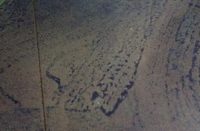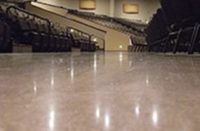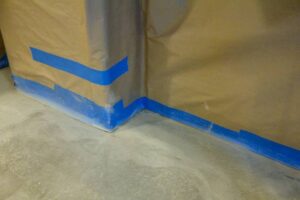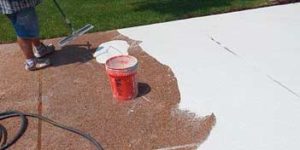The “first cut” is the foundation for the polished concrete floor that you are going to create. But what is a “first cut”? In speaking with a wide range of concrete polishers, I’ve found that there seems to be three ways this question can be answered.
To some concrete polishers, “first cut” means starting with 100-grit resin diamonds, and that’s it. They proceed to 200-grit resins without evaluation of what has occurred during the first pass.
To others, “first cut” means to randomly scratch some of the surface with a metal or a resin depending upon the bid and then polish the concrete.
To still others, “first cut” actually grinds the slab open and flat with a coarse metal bond. After it, they go step by step until the concrete is polished to their customer’s satisfaction.
All of these methods of dealing with the initial grind will produce a polished concrete floor. But these floors are not created equal and will not perform equally. We need to start doing a better job of informing and educating our customers about the cost, performance, longevity, and maintenance differences they can expect from each of these approaches.
Influences and limitations
When considering how to approach polishing a particular floor, there are many influences that will determine what ultimately happens to that particular piece of concrete.
Pricing is the first and most common influence. This occurs during the bidding, negotiation or sales process. When we hear what the owner wants, we have a price in mind that we can accept for doing the floor. Then there is the number that the client is willing to pay. This is where the compromises begin. They may include removing a step, not doing the edges, or agreeing to accept coloration differences or a floor that is less flat. Eventually a deal will be struck. That price will determine how the first cut is performed.
A second major influence is time allotted. The owner or general contractor says that the job needs to be done in two days, while you on the other hand were thinking that you would need a week to do the job right. What impact does this have on how you approach the first cut?
Yet another influence is equipment available. If you have only a 21-inch lighter-weight grinder that cannot really cut a floor flat, how will that impact your first cut when you’re looking at a hard-troweled or burned concrete floor? Or let’s say the project is in a building without an elevator, and only a 21-inch grinder will fit up the stairway in pieces that can be put back together after it has been carried up. How will this affect the first cut? In both of these examples, the compromises are likely to include a final floor that is less flat than desired, and the coloration and final polish may be uneven.
Access to water is an influence. If no water is available, an aggressive first cut may simply not be possible, as wet cutting is sometimes the only method that will cut through a burned floor. Or if you are working on the second level, the owner may not allow water to be used, as it could seep into the floor and potentially leak through.
Lack of training and experience may also limit the options on the first cut. Did the diamonds glaze? Did the diamonds barely scratch the surface, and should the crew have increased or decreased the head or disc speeds, or walked faster or slower? With limited knowledge, the floor is often “mowed” like a lawn, and this ultimately affects how the floor will turn out. Customer knowledge is a factor as well. Perhaps your owner saw the polished floor at the local library, and wants her floor to look just like that. Her level of experience affects her expectations, and the customer’s desire for, say, no aggregate exposure at all will clearly have an impact on how you can approach the floor and perform the first cut.
The polishing contractor may not have seen other limitations before agreeing on a price for a job. For example, 3,000-psi concrete may have been specified for the mix design, but once poured and cured, the slab has become 5,000 psi, so you suddenly require additional coarse diamonds. Or it goes the other way and the concrete is sandy and abrasive. As soon as you put diamonds to the surface, you are pushing a pile of dust, and the diamonds themselves can wear within 1,000 square feet.
In the case of either air-entrained concrete or structurally cracked or crazed concrete, there will be lots of little holes or spaces that will need to be filled. The approach will be to grind with silicate-based Certi-Shine Fusion repair material (from Vexcon Chemicals Inc.) that fills the voids on the surface – this procedure needs to be performed during a metal step, not a resin step. If a self-leveler needs to be poured over the entire floor, the first cut will have to be adjusted accordingly.
With the advent of laser screeding and other super-flat technology, floors are being poured and troweled flatter than ever before. The FF (flatness) and FL (levelness) numbers of a slab will also influence which grit diamonds you select for the initial approach to the floor. An older slab with birdbaths and high spots will require coarser diamonds and harder initial cutting to flatten the floor. As a general rule, the flatter the slab, the higher the grit of diamond you can start with.
There are two areas where all concrete polishers can agree. First, each concrete slab is different. Second, the single most expensive and labor-intensive cut is a coarse-grit metal bond diamond that actually grinds and flattens the concrete surface. This cut will also consume the most diamonds and generate the most concrete powder or slurry for handling and disposal. The very next metal bond, the next level up, will be the second most costly.
This type of cut will ultimately produce the flattest, truest and most reflective floor. If properly densified and polished up, it will also be the most durable floor. Cutting the entire floor, removing the high spots and actually grinding the lows with the same grit diamond will refine (hone and polish) at the same rate. After transitioning from a coarser-grit to a finer-grit diamond, the concrete will all be cut and honed by the same diamond grits hitting the entire surface.
How to approach the customer
Given that there is more than one way to make the first cut (and polish concrete), it is the concrete polisher’s obligation to educate the customer and then meet expectations. The solution may be to offer bids on more than one option and price them accordingly. This can help you explain performance differences so that the floor that they pay for will meet their long-term expectations as well as please the eye on the day they pay you.
Here’s an example:
Option one: Cut, flatten, hone, densify and polish the concrete at a cost per square foot of X dollars. This floor will have several features and benefits, including a cream, salt-and-pepper or aggregate finish, a flatter surface, truer reflections with less haze (better DOI, or distinctness of image), exceptional durability, excellent shine retention, and reduced maintenance.
Option two: Scratch the surface with a lower resin or combination diamond, then densify and polish, at a cost per square foot of X minus Y dollars. This option includes “riding the highs” so that no aggregate is revealed and polishing to a slight cream and/or salt-and-pepper finish. This floor may have an undulating or wavy surface with low dull areas and less durability, and it will require surface conditioners with densifiers and diamond burnishing. Repolishing will likely be needed, depending upon the level of traffic and maintenance. The initial “surface polish” is temporary, and the concrete may be referred to as a “capped” floor.
Option two is often the floor delivered by default due to the limitations and influences we have discussed. This is the type of floor that is causing concrete polishing to be in danger of losing its reputation as the “greatest floor on earth,” a durable, high-shine, low-maintenance floor. If this is all the customer can buy, then make sure the customer understands its performance limitations.















